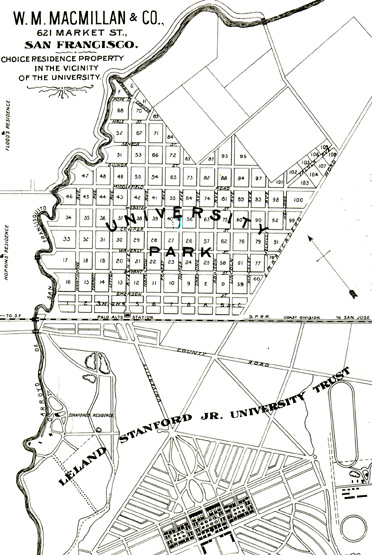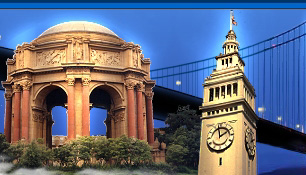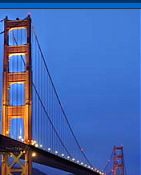|
Timothy Hopkins, adopted son of Mark Hopkins, became treasurer
of the Central Pacific Railroad in 1883 and treasurer of the Southern
Pacific Railroad in 1885. Leland Stanford was president of both
railroads and a close friend of Timothy Hopkins. At this time Leland
Stanford and Jane Lathrop had in mind to establish a town across
El Camino Real to support the needs of Stanford University, including
student housing, shopping, and recreation, but no liquor. The Stanfords
asked the leaders of Menlo Park and Mayfield to close their saloons,
but were answered "No."
Leland Stanford advanced funds to Timothy Hopkins to purchase 697.55
acres from Henry W. Seale, and a smaller parcel from the relatives
of Maria Louisa Greer. Hopkins drew up a map, named the streets,
and recorded the map in 1889, calling it University Park. The map
below is from a brochure advertising the area. The new town extended
from San Francisquito Creek to Embarcadero Road and from the railroad
on El Camino Real to Middlefield Road.
 Properties
being put up for auction, 3,000 people bought 106 lots, the highest
price $287.00 and the lowest $122.50. In 1892 University Park officially
became Palo Alto. Timothy Hopkins served as a Stanford University
trustee for fifty-one years, donated his private collection of books
to the University Library, established the Hopkins Marine station
at Pacific Grove, helped create and support the Lane Medical Library,
and, with his wife, organized the Stanford Home for Convalescent
Children. Properties
being put up for auction, 3,000 people bought 106 lots, the highest
price $287.00 and the lowest $122.50. In 1892 University Park officially
became Palo Alto. Timothy Hopkins served as a Stanford University
trustee for fifty-one years, donated his private collection of books
to the University Library, established the Hopkins Marine station
at Pacific Grove, helped create and support the Lane Medical Library,
and, with his wife, organized the Stanford Home for Convalescent
Children.
Many of Stanford University's first faculty members settled in the
Professorville neighborhood of Palo Alto. Stanford University allowed
faculty to build houses on Stanford land, but would only lease,
not sell, the land. Professorville was the closest place to the
campus and downtown Palo Alto that was not owned by the university.
Faculty who preferred to own rather than lease land built homes
there.
The developer of the tract being eager to sell the land, he sold
various lot sizes, including full blocks and half blocks, consequently
lot sizes in Professorville varied greatly in size and location.
The owners of the large lots then sold off portions of their properties,
starting at the outer edges until the original buildings were on
modest sized lots.
With Stanford University's support, saloon days faded and Palo Alto
grew to the size of Mayfield. On July 2, 1925, Palo Alto voters
approved the annexation of Mayfield. The two communities were officially
consolidated on July 6, 1925.
Professorville, now a registered national historic district, is
approximately bounded by Emerson, Addison, Cowper, and Embarcadero.
The district includes a large number of well preserved residences
dating from the 1890s, including 833 Kingsley, 345 Lincoln, and
450 Kingsley.
1044 Bryant was the home of Russell Varian, co-inventor of the Klystron
tube. The Federal Telegraph laboratory site, 218 Channing, is a
California Historical Landmark recognizing Lee de Forest's 1911
invention of the vacuum tube and electronic oscillator at that location.
While not open to the public, the garage where William Hewlett and
David Packard began their company is at 367 Addison Avenue. Hewlett
Packard recently restored the house and garage. A second historic
district on Ramona Street is downtown between University and Hamilton
Avenues.
|









